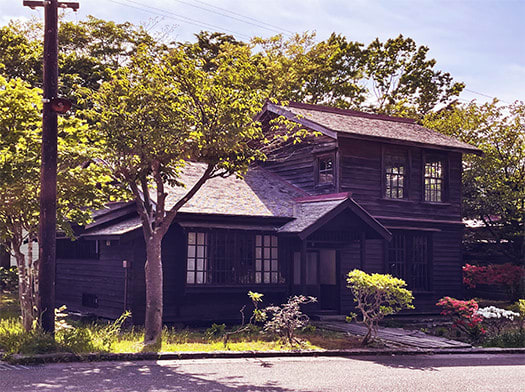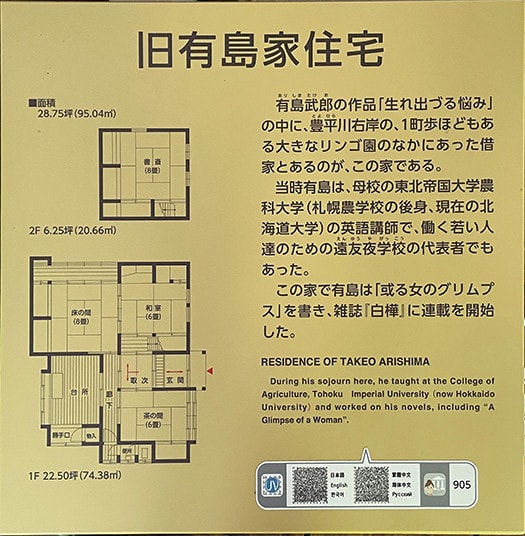

きのうの続篇です。
世間的には東京都知事選挙の話題が大きかったようですが、思った以上にステルス「自公」小池知事は強かったのと、立憲共産vsマスコミ批判の2位争いでは、まったく組織を持たないマスコミ批判派が勝利したことが、衝撃的。これは時代遅れマスコミに取ってイタいところを突かれたか。で、引き続いて政治世論はたぶん自由民主党の総裁選に興味が移っていくことでしょう。さて。
有島武郎邸、それも新婚早々の時期の大学教員としての住まい。経済的成功を収めていた裕福な有島家の長男として、北大を卒業後、欧米遊学を経てふたたび札幌に移転してきた人生時期。なんだけれど、結婚自体は親が勧める良家の娘さんをめとって新婚生活を始めている。伝統ライフスタイル派。
有島の住宅経歴を見ていると、この高級賃貸住宅を経て、自ら設計プランに没頭したと思われる現北大にほど近い土地に建てた新築住宅の直前の住まいになる。この当時の賃貸住宅の常識のなかでもこの家はかなり個性的とも思われるのだけれど、かれはきっとこの住環境に対しての改善点を大きな教訓として、新築計画に向かっていたと推定されるのです。
今この家は北海道開拓の村に移築保存されているけれど、そもそもは「豊平川右岸の、1町歩ほどもある大きなリンゴ園のなかにあった」と有島の作品「生まれ出ずる悩み」で記述しているとされる。
推測では自然環境豊かな農園のなかの住まい、というコンセプトに強く惹かれたのではないかと思っている。当時の札幌の街は最初期の「官都」都市計画からどんどんと都市規模が膨らんでいった時期。
豊平川右岸というのは、そういった札幌の市街区に対して田園がひろがる地域という認識が強かったように思われるのです。地域の歴史推移を見ると以下。(札幌市豊平区HPより)
〜明治4年(1871年)に現在の岩手県などから多くの人が平岸や月寒に移住。平岸村、月寒村、豊平村の合併などを経て、明治41年に町制が施行され豊平町となった。農業が盛んで、特にリンゴは明治時代から平岸を中心に栽培され、「平岸リンゴ」は昭和初期には海外に輸出されるほどであった。〜
有島は明治43年から翌年に掛けてこの家に住んだので、ちょうど豊平町の町制施工時期にあたる。札幌の「ベッドタウン」郊外住宅地域という位置付けになるのだろう。
最初期の札幌市街地の拡大時期に相当するように思える。
そのように見返してみると、有島の住宅選択の考え方と当時の札幌の住宅世相がともに再生されてきて興味が深まっていく。どうもこういう方面にわたしのライフワークは収斂する予感(笑)。
English version⬇
[At the end of the Meiji period, Takeo Arishima's choice of residence, "Sapporo's Bedtown"-2
Referring to the transition of Sapporo Toyohira-ku, it corresponds to the period when the population of the surrounding area increased along with the expansion of the Sapporo urban area. The first "bed town" that continues to the present day...
This is a continuation of yesterday's report.
The Tokyo gubernatorial election seems to have been a major topic of public interest, but the fact that the stealth "autocrat" Governor Koike was stronger than expected and that the second-place race between the Rikken Kyosan and the media critics was won by the media critics who have no organization at all is shocking. This was a bad moment for the outdated mass media. And the political public will probably continue to be interested in the Liberal Democratic Party's presidential election. Now, let's look at the house of Takeo Arishima.
Takeo Arishima's residence, where he lived as a university faculty member during his early years as a newlywed. He was the eldest son of the wealthy and financially successful Arishima family, and after graduating from Hokkaido University and studying in Europe and the United States, he moved back to Sapporo at that time in his life. Although he is the eldest son of a wealthy and financially successful family, he married the daughter of a good family recommended by his parents and started his new life as a newlywed. He is a traditional lifestyleist.
Looking at Arishima's housing history, we can see that after this high-class rental house, he lived just before the new house he built on a plot of land close to the current Hokkaido University, where he seems to have immersed himself in design planning. Although this house is considered to be quite unique even in the common sense of rental housing at that time, it is assumed that he learned a great deal from the improvements made to this living environment as he was planning to build a new house.
Although the house has been relocated and is now preserved in the Hokkaido Kaitakunomura, it was originally located "in a large apple orchard on the right bank of the Toyohira River, about one township in size," as described in Arishima's work, "Born of a Trouble.
My guess is that he was strongly attracted to the concept of living in a farm in a rich natural environment. At that time, the city of Sapporo was in the process of expanding its urban scale from the initial "government capital" urban plan.
The right bank of the Toyohira River was strongly perceived as an area where the countryside spread out in contrast to the urban area of Sapporo. The historical transition of the area is as follows. (From the website of Toyohira-ku, Sapporo)
〜In 1871, many people from what is now Iwate Prefecture moved to Hiragishi and Tsukisamu. After the merger of Hiragishi, Tsukisamu, and Toyohira villages, the town was incorporated in 1908 and became Toyohira-cho. Agriculture is flourishing, especially apples have been grown mainly in Hiragishi since the Meiji Era, and "Hiragishi apples" were even exported overseas in the early Showa Era. ~.
Arishima lived in this house from 1908 to the following year, which was right around the time when Toyohira-cho was established as a town. The area was positioned as a "bedroom town" suburban residential area of Sapporo.
It seems to correspond to the period of the first expansion of the urban area of Sapporo.
Looking back at the data in this way, I am interested in the replay of both Arishima's housing selection ideas and the state of housing in Sapporo at that time. I have a feeling that my life's work will converge in this direction (laugh).



















